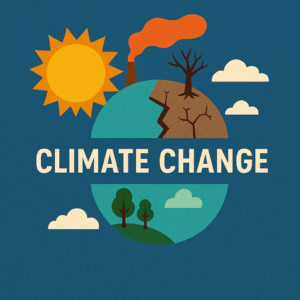Climate change stands as one of the most formidable challenges of the 21st century, with soaring temperatures, intensifying weather extremes, and widespread environmental degradation threatening both ecosystems and human well-being. Yet, amidst these challenges, technology emerges as a beacon of hope, offering groundbreaking solutions to mitigate climate change and promote sustainability.
From harnessing the power of renewable energy and optimizing smart grids to advancing carbon capture technologies and leveraging AI-driven climate models, innovation is reshaping our approach to environmental preservation. This article delves into the dynamic intersection of climate change and technology, showcasing pioneering advancements that are paving the way for a more sustainable future.
Renewable Energy Revolution
One of the most significant technological advancements in combating climate change is the widespread adoption of renewable energy sources. Solar power, wind energy, and hydropower have become more efficient and cost-effective, reducing dependency on fossil fuels and lowering greenhouse gas emissions.
- Solar Power: Advances in photovoltaic (PV) technology have led to higher energy conversion efficiency, making solar panels more accessible for homes, businesses, and large-scale power plants.
- Wind Energy: The development of offshore and onshore wind farms, along with innovations in turbine design, has significantly increased energy output.
- Hydropower & Geothermal Energy: These sustainable energy sources continue to evolve, with innovations in pumped-storage hydropower and enhanced geothermal systems improving reliability and efficiency.
Smart Grids and Energy Storage
Transitioning to a clean energy future requires smart grids and efficient energy storage solutions to ensure a stable and resilient power supply.
- Smart Grids: These AI-driven systems optimize electricity distribution, reduce energy waste, and integrate renewable energy sources efficiently.
- Battery Storage Technologies: Lithium-ion batteries, solid-state batteries, and emerging hydrogen fuel cells play a vital role in storing excess renewable energy, making it available during peak demand periods.
- Decentralized Energy Solutions: Microgrids and distributed energy resources (DERs) enable localized power generation, reducing reliance on centralized fossil-fuel-based grids.
Carbon Capture and Climate Engineering
To mitigate climate change, scientists and engineers are developing innovative carbon capture and storage (CCS) technologies, as well as geoengineering solutions to regulate the Earth’s climate.
- Carbon Capture and Storage (CCS): Technologies that capture CO2 emissions from industrial processes and power plants prevent greenhouse gases from entering the atmosphere. Direct Air Capture (DAC) systems extract CO2 from the air for storage or reuse.
- Geoengineering: Solar radiation management (SRM) techniques, such as stratospheric aerosol injection, aim to reflect sunlight and cool the planet, though these solutions remain controversial due to potential environmental risks.
- Nature-Based Solutions: Reforestation, afforestation, and regenerative agriculture practices enhance carbon sequestration while restoring biodiversity.
AI and Big Data in Climate Monitoring
Artificial Intelligence (AI) and big data analytics are transforming climate science, enabling accurate predictions and data-driven decision-making.
- Climate Modeling: AI-powered models process vast datasets to simulate climate scenarios, helping scientists understand future risks and develop mitigation strategies.
- Satellite Monitoring: Earth observation satellites track deforestation, ice sheet melting, and ocean temperature changes, providing real-time climate insights.
- AI-Driven Disaster Response: Machine learning algorithms analyze climate patterns to predict and prepare for natural disasters like hurricanes, wildfires, and floods.
Sustainable Agriculture and Food Technology
The agricultural sector is both a contributor to and a victim of climate change. Technological innovations are helping to reduce emissions, conserve resources, and increase food security.
- Precision Agriculture: IoT sensors, drones, and AI analyze soil health, monitor crop conditions, and optimize irrigation, reducing water and fertilizer use.
- Vertical Farming and Hydroponics: These urban farming techniques reduce land use, minimize water consumption, and ensure year-round food production.
- Lab-Grown Meat and Alternative Proteins: Plant-based and cultivated meat reduce reliance on livestock farming, significantly cutting methane emissions.
Electric Vehicles and Sustainable Transportation
The transportation sector is undergoing a green revolution with the rise of electric vehicles (EVs), hydrogen fuel cells, and smart mobility solutions.
- Electric Vehicles (EVs): Advances in battery technology, charging infrastructure, and government incentives are accelerating the transition to EVs.
- Hydrogen Fuel Cells: Hydrogen-powered vehicles provide a clean alternative for long-haul transport, reducing carbon emissions.
- Public Transit Innovations: Smart transportation networks, autonomous electric buses, and high-speed rail systems contribute to reducing traffic congestion and urban air pollution.
Circular Economy and Waste Management
Sustainable technology is driving the shift toward a circular economy, where waste is minimized and resources are reused efficiently.
- Recycling Innovations: AI-powered sorting systems improve recycling efficiency, ensuring materials are repurposed effectively.
- Biodegradable and Eco-Friendly Materials: Advances in bioplastics, compostable packaging, and upcycling technologies reduce plastic pollution.
- E-Waste Management: Sustainable practices in electronic recycling recover valuable materials, reducing landfill waste and environmental harm.
Conclusion
Technology is a powerful ally in the fight against climate change, providing innovative solutions to reduce emissions, enhance sustainability, and adapt to environmental challenges. From renewable energy and AI-driven climate models to sustainable agriculture and electric mobility, these advancements pave the way for a cleaner and greener future. However, global collaboration, policy support, and responsible innovation are essential to ensure that these technologies are deployed effectively and equitably. By harnessing the power of innovation, we can address climate change and build a more sustainable world for future generations.


